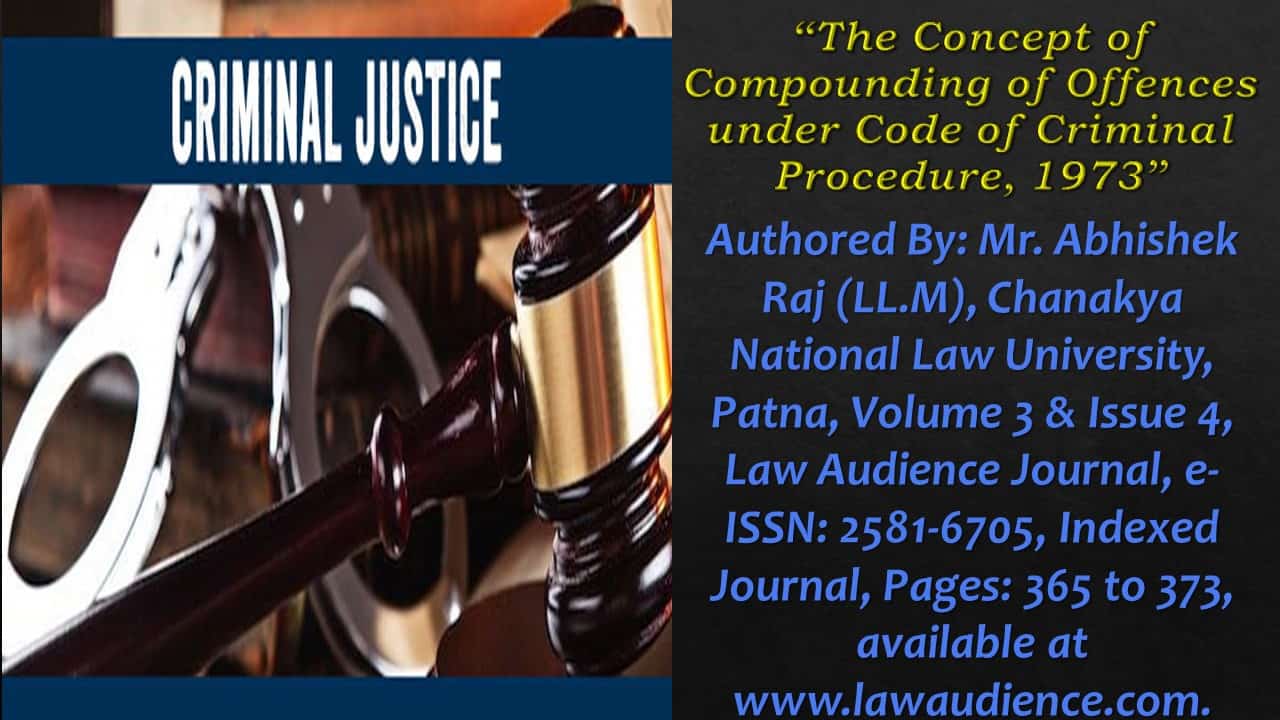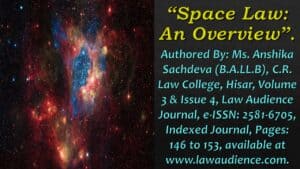Click here to download the full paper (PDF)
Authored By: Mr. Abhishek Raj (LL.M), Chanakya National Law University, Patna,
Click here for Copyright Policy.
I. INTRODUCTION:
“It has long been recognised that Interest Reipublicae Ut Sit Finis Litium. This Latin maxim means that it is in the interest of the state that there must be an end to litigations. However, in the Indian legal systems it may be a decade or two before a litigation actually ends. Everything right from the attitude of the parties to the snail-paced procedure of the court system is to be blamed for it. The Indian judicial system is reeling under a massive pendency of cases. A cumulative of around four and a half crore cases are pending before courts at all levels.
It is speculated that even if no new cases come up, a situation that is impossible, the cases pending before the Supreme Court will itself take around 1.3 years to be disposed off. Then there are cases pending before the High Courts and the subordinate courts which will take 3 years each to be disposed off.[1] Surprising but true, these statistics reflect the size of the humongous mountain of pending cases facing our judiciary. To deal with such situation the legislature armed the criminal justice procedure with a very potent weapon that when invoked can significantly reduce the time taken to dispose off a case. This weapon is compounding of offences. In this article we shall see the meaning of compounding of offences, its jurisprudential basis and the provisions relating to compounding of offences in the Code of Criminal Procedure, 1973”.
II. MEANING OF COMPOUNDING OF OFFENCES:
Section 320 of the Code of Criminal Procedure encapsulates the entire procedure of compounding of offences. However, the term compounding is nowhere defined in the Code. To understand the meaning of compounding we thus have to look elsewhere. Merriam-Webster defines compound as “to agree for a consideration not to prosecute (an offense)” or “to settle amicable” or “adjust by agreement”.[2] In ordinary sense compounding is said to take place when two people come to a settlement. In legal sense compounding takes place when the victim and the accused come to an agreement by which the victim agrees to not prosecute the accused.
In Murray vs. Queen Empress[3], the hon’ble Calcutta High Court explained the concept of compounding as the victim of the crime abstaining from prosecution on receiving certain gratification. The gratification can be of any nature, pecuniary or otherwise.
The explanation behind such forbearance to prosecute may be that the victim has gotten monetary compensation or other form of gratification from the accused which was sufficient for him to make a decision to not prosecute him. The forbearance may also be due to the accused displaying repentant attitude. Compounding is hence basically a process whereby the parties settle their differences. If the compounding is according to the law, the result will be acquittal of the accused and the end of the litigation.
III. JURISPRUDENTIAL ANALYSIS OF THE CONCEPT OF COMPOUNDING:
The concept of compounding of offences has come a long way. Today it is seen as a legitimate way of bringing a litigation to its end. The parties can settle the dispute amongst themselves in a peaceful way in all those offences which the law recognises as compoundable. However, it was not always so. Earlier compounding of offences was not seen as a procedural alternative to a full-fledged trial. Rather it was seen as a crime in itself.
The Black’s Law Dictionary in its fifth edition defined ‘compounding crime’ as “receipt of some property or other consideration in return for an agreement not to prosecute or inform on one who has committed a crime”. There are three elements to this offence at common law, and under the typical compound statute;
- The agreement not to prosecute;
- Knowledge of actual commission of a crime; and
- The receipt of some consideration.”[4]
And as “The offence committed by a person who, having been directly injured by a felony, agrees with the criminal that he will not prosecute him, on condition of the latter making reparation, or on receipt of a reward or a bribe not to prosecute.”[5] In P Ramanatha Aiyar’s Advanced Law Lexicon ‘compounding a crime’ is defined as “the offence of either agreeing not to prosecute a crime that one knows has been committed or agreeing to hamper the prosecution”.[6]
Further Section 213 and Section 214 of the Indian Penal Code also criminalised compounding.
Section 213 – Taking gift etc. to screen an offender from punishment[7];
Whoever accepts or attempts to obtain, or agrees to accept, any gratification for himself or any other person, or any restitution of property to himself or any other person, in consideration of his concealing an offence or of his screening any person from legal punishment for any offence, or of his not proceeding against any person for the purpose of bringing him to legal punishment,
If a capital offence: shall, if the offence is punishable with death, be punished with imprisonment of either description for a term which may extend to seven years, and shall also be liable to fine;
If punishable with imprisonment for life, or with imprisonment: and if the offence is punishable with imprisonment for life, or with imprisonment which may extend to ten years, shall be punished with imprisonment of either description for a term which may extend to three years, and shall also be liable to fine;
And if the offence is punishable with imprisonment not extending to ten years, shall be punished with imprisonment of the description provided for the offence for a term which may extend to one-fourth part of the longest term of imprisonment provided for the offence, or with fine, or with both.
Section 214 – Offering gift or restoration of property in consideration of screening offender[8];
Whoever gives or causes, or offers or agrees to give or cause, any gratification to any person, or restores or causes the restoration of any property to any person, in consideration of that person’s concealing an offence, or of his screening any person from legal punishment for any offence, or of his not proceeding against any person for the purpose of bringing him to legal punishment;
If a capital offence: shall, if the offence is punishable with death, be punished with imprisonment of either description for a term which may extend to seven years, and shall also be liable to fine;
If punishable with imprisonment for life, or with imprisonment: and if the offence is punishable with imprisonment for life, or with imprisonment which may extend to ten years, shall be punished with imprisonment of either description for a term which may extend to three years, and shall also be liable to fine;
And if the offence is punishable with imprisonment not extending to ten years, shall be punished with imprisonment of the description provided for the offence for a term which may extend to one-fourth part of the longest term of imprisonment provided for the offence, or with fine, or with both.
Exception: The provisions of sections 213 and 214 do not extend to any case in which the offence may lawfully be compounded.
It is clear that both of these sections are complementary to each other. They are almost the same except for the person they engulf in penal liabilities. While Section 213 makes the person who takes or agrees to take any gratification to conceal a crime or to screen an offender or to not prosecute a crime liable for penalty, Section 214 makes the person who gives or agrees to give any gratification to conceal a crime or to screen an offender or to not prosecute a crime liable for penalty. The most important development that took place in both of this section is the insertion of the exception at the end of Section 214. This exception makes it clear that where the law itself allows compounding of an offence, the parties who compound the offence will not be liable under the penal provisions of either Section 213 or Section 214. However, what makes the introduction of this exception very interesting is that it was introduced in the year 1882[9] while the provision relating to the compounding of offences was introduced through an amendment of the erstwhile Code of Criminal Procedure in the year 1872 itself. The Code in Section 188 provided that the parties could compound the offences in an out of court settlement or could compound the offence with the leave of the court in the court itself. However, the erstwhile Code did not provide any list of offences that were compoundable. It was left to the judicial discretion to decide in respect of any offence whether it was compoundable or not.
The list of offences that could be lawfully compounded was for the first time provided when the Code of Criminal Procedure was amended in 1882.[10] The list was enhanced by adding some more offences to it through the amendment to the Code in the year 1898.[11] So, we can safely say that the compounding of the offence that was earlier seen as an offence in itself got legal sanctity through the aforesaid amendments in the Code of Criminal Procedure and the Indian Penal Code. In the code of Criminal Procedure, 1973 the provisions relating to the compounding of offences is contained in Section 320.
IV. ANALYSIS OF SECTION 320 OF THE CODE OF CRIMINAL PROCEDURE, 1973 – COMPOUNDING OF OFFENCES:
The sub section (1) of Section 320 deals with the offences that can be compounded without the permission of the court. The section has a Table appended to it. The Table consists of three columns. The offences that are compoundable under this sub section are mentioned in the first two columns. The first column of the Table describes the offence. The Second column mentions the corresponding provision of the Indian Penal Code. The third column specifies the person who can compound the offence.[12] Usually the person who can compound the offence is the victim of the offence. A closer look at the Table discloses the fact that the offences mentioned in it are relatively non-serious and are mostly private in nature. Society at large remains largely unaffected by these offences. The offences do not prescribe very severe punishments with the most severely punishable offences amongst them carrying a maximum punishment between five to seven years. Sub section (2) deals with those offences that are compoundable only with the permission of the court in which the proceedings relating to that offence are pending. This sub section also contains a Table. Similar to the Table in the previous sub section this table also consists of three columns. The offences that are compoundable under this sub section are mentioned in the first two columns.
The first column of the Table describes the offence. The Second column mentions the corresponding provision of the Indian Penal Code. The third column specifies the person who can compound the offence.[13] The rationale behind making these offences compoundable only with the permission of the court is that they are more serious in nature than the offences governed by the provision of sub section (1). Sub section (3) makes attempt and abetment to commit the offences mentioned in the sub sections (1) and (2) compoundable in similar manner as the offences themselves. It also makes compoundable the cases of those accused who are guilty of the offences under Section 34 and Section 149 of the Indian Penal Code.[14] This sub section was amended in the year 2009.[15]
It was done to cure the defect of non compoundablity of attempt and abetment of the offences and the non compoundablity in cases of the accused charged with the offence under Section 34 and Section 149 when the offence itself was compoundable. Sub section (4) deals with the situation where the person named in the Table as competent to compound an offence is not able to compound either because of i) minority, ii) idiocy iii) lunacy, iv) incompetence to contract or v) death. Clause (a) of the sub section allows the person competent to contract on behalf of the person suffering the disabilities mentioned in point i) to point iv) to compound the offence, which the person suffering from the disability is competent to compound, with the permission of the court.[16] Clause (b) allows the legal representative of the deceased person, who was competent to compound, to compound the offence with the consent of the court.[17] Sub section (5) deals with the situations where the case has already been committed to trial or where the accused is already convicted and there is a pending appeal. In such situations irrespective of the Table in which the offence is enlisted, the offence is compoundable only with the permission of the court in which the cases are so committed or the court in which the appeal is pending.[18] Sub section (6) makes it clear that the High Court or the Court of Session, using their power of revision under Section 401, can allow compounding of the offences compoundable under Section 320.[19]
Sub section (7) deals with the eventuality where the accuse is liable for an enhanced punishment or a punishment of a different kind for the offence that he seeks to get compounded due to the fact of his being convicted previously of an offence. In this case the compounding is not allowed.[20] This provision has been inserted to make sure that the concept of compounding which presumes repentance on the part of the accused does not become a matter of convenience for repeat offenders. Sub section (8) lays down that the effect of a compounding which is done in accordance with the provisions of Section 320 is acquittal of the accused. However, where there are more accused than one, compounding with any one of them will result in acquittal of only that accused.[21] Sub section (9) lays down in unequivocal terms that all the compounding of offences will take place only under this section.[22] The 41st Report of the Law Commission of India explained the basis of making certain offences compoundable. It explained the broad principle governing the provisions making certain offences compoundable in the Code of Criminal Procedure, 1898 as the essentially private nature and relatively non-seriousness of the offences.[23] The 154th Report of the Law Commission of India explained the rationale behind making certain offences compoundable under the Code of Criminal Procedure, 1973. It said that the rationale was to ensure peace and harmony by giving effect to the chastened attitude of the accused and the praiseworthy attitude of the complainant. The commission also recommended enhancing the list of compoundable offences by inserting certain hitherto non-compoundable offences to it. However, the Report also maintained that offences against public at large must remain non-compoundable irrespective of the fact of how small they are.[24] The 237th Report of the Law Commission of India also explained the rationale behind compoundabability of certain offences. The Commission observed that the victim may have gotten compensation from the accused or there may have been a change in attitude between the accused and the victim. The accused may have repented committing the offence and may have become a chastened person and the victim may have decided to forgive him. The law taking note of such eventualities provides a remedy to bring the criminal proceedings to an end in relation to certain types of offences.[25]
In Biswabahan Das vs. Gopen Chandra Hazarika[26], the hon’ble Supreme Court observed that where the offence is of such nature that it affects the victims in their individual capacity, a sufficient redressal for such an offence may be compounding. (Three Judges Bench comprising of hon’ble G.K. Mitter, J., hon’ble K.N. Wanchoo, J. and hon’ble J.M. Shelat J.)
In Sheonandan Paswan vs. State of Bihar[27], the matter before the hon’ble Supreme Court required it to interpret the provisions of Section 321 of the Code of Criminal Procedure, 1973. Section 321 is related to withdrawal from prosecution of any person of the Public Prosecutor or the Assistant Public Prosecutor. The Court drew an analogy between Section 321 and Section 320 and thought it fit to analyse the latter section for the purpose. The court observed that the expressions ‘with the permission of the court’ and ‘with the consent of the court’ that find mention in Section 320 only contemplate supervisory power of the court in this regard with respect to the matters with respect to which such permission or consent is required. The court does not have to enter into an enquiry whether the trial will end in a conviction or an acquittal. The Court must not enter into evaluation of the evidences against the accused. Its role is very supervisory. It just has to ensure that the accused is not seeking a compromise by applying deceitful or unfair means. The court also observed that the application for compounding under Section 320 can be moved at any stage. (Constitutional Bench comprising of hon’ble P.N. Bhagwati, CJ., hon’ble E.S. Venkataramiah, J., hon’ble V. Khalid, J., hon’ble G.L. Oza, J., and hon’ble S. Natrajan, J.)
Analysing these case laws, it can be said that the basic principle behind compounding of offences as it is provided in our criminal justice system is that firstly if compounding offers sufficient redressal to the victim, the same must be allowed at any stage of the trial according to the provisions of Section 320. This is very crucial as it helps not only in bringing about an amicable settlement amongst the parties but also in reducing the burden of the court. Secondly where the offence is of public nature, the same must not be allowed to be compounded however insignificant the damage is and even when there is a direct damage to a certain victim. This principle is also very crucial. Public trust in the criminal justice system will erode if such offences are allowed to be compounded. Further punishments awarded for the offences reinforce society’s perception about permissible limit of action. If offences affecting public at large are allowed to be compounded, it will adversely affect the society’s perception about what course of action is permitted and what is not. This line of argument is also in consonance of the judgment of the Queen’s Bench in Keir vs. F. Leeman and Pearson[28], where it was observed by Lord Denman, C.J. that in cases of offence in which the victim can recover damages through an action, the law will allow a compromise. However, where the offence is of public nature no agreement to stifle a prosecution is permissible.
Cite this article as:
Mr. Abhishek Raj, “The Concept of Compounding of Offences under Code of Criminal Procedure, 1973”, Vol.3 & Issue 4, Law Audience Journal (e-ISSN: 2581-6705), Pages 365 to 373 (21st May 2022), available at https://www.lawaudience.com/the-concept-of-compounding-of-offences-under-code-of-criminal-procedure-1973/.
Footnotes & References:
[1] Pendency and Vacancies in the Judiciary, PRS Legislative Research, available at: https://prsindia.org/policy/vital-stats/pendency-and-vacancies-in-the-judiciary#:~:text=Between%202010%20an d%202020%2C%20pendency,and%2012.3%25%20in%20High%20Courts., last seen on 04/04/2022.
[2] Compound, Merriam-Webster, available at https://www.merriam-webster.com/dictionary/compound, last seen on 06/04/2022.
[3] Murray v. Queen Empress, (1893) ILR 21 Cal 103.
[4] Black’s Law Dictionary, 259 (5th ed., 1979).
[5] Ibid.
[6] P.Ramanatha Aiyar’s Advanced Legal Lexicon, 932 (3rd ed., 2005).
[7] S. 213, The Indian Penal Code, 1860.
[8] S. 214, The Indian Penal Code, 1860.
[9] S. 6, The Indian Penal Code Amendment Act, 1882.
[10] S. 345, The Code of Criminal Procedure, 1882.
[11] S. 345, The Code of Criminal Procedure, 1898.
[12] S. 320(1), The Code of Criminal Procedure, 1973.
[13] S. 320(2), The Code of Criminal Procedure, 1973.
[14] S. 320(3), The Code of Criminal Procedure, 1973.
[15] S. 23(iii), The Code of Criminal Procedure (Amendment) Act, 2008.
[16] S. 320(4)(a), The Code of Criminal Procedure, 1973.
[17] S. 320(4)(b), The Code of Criminal Procedure, 1973.
[18] S. 320(5), The Code of Criminal Procedure, 1973.
[19] S. 320(6), The Code of Criminal Procedure, 1973.
[20] S. 320(7), The Code of Criminal Procedure, 1973.
[21] S. 320(8), The Code of Criminal Procedure, 1973.
[22] S. 320(9), The Code of Criminal Procedure, 1973.
[23] 41st Law Commission of India Report, The Code of Criminal Procedure, 1898, 213 (1969), available at https://lawcommissionofindia.nic.in/1-50/Report41.pdf, last seen on 19/04/2022.
[24] 154th Law Commission of India Report, On Code of Criminal Procedure, 1973 (Act No. 2 of 1974), 47 (1996), available at https://lawcommissionofindia.nic.in/101-169/Report154Vol1.pdf, last seen on 10/04/2022.
[25] 237th Law Commission of India Report, Compounding of (IPC) Offences, 6 (2011), available at https://lawcommissionofindia.nic.in/reports/report237.pdf, last seen on 12/04/2022.
[26] Biswabahan Das v. Gopen Chandra Hazarika, AIR 1967 SC 895.
[27] Sheonandan Paswan v. State of Bihar, (1987) 1 SCC 288.
[28] Keir v. F. Leeman and Pearson, (1844) 6 Queen’s Bench Reports 308.




